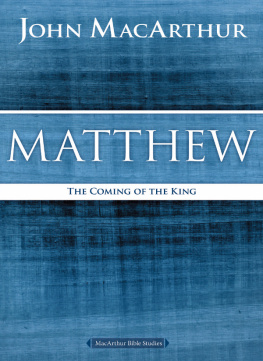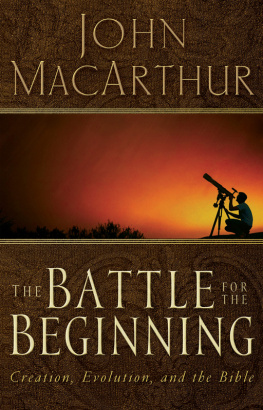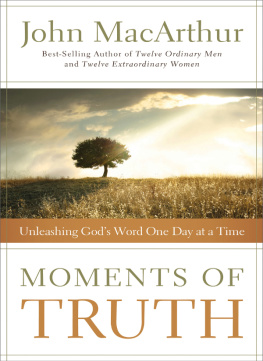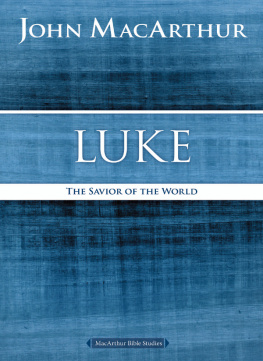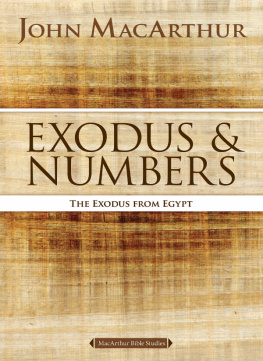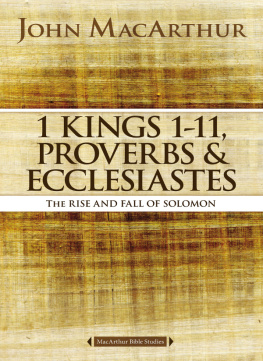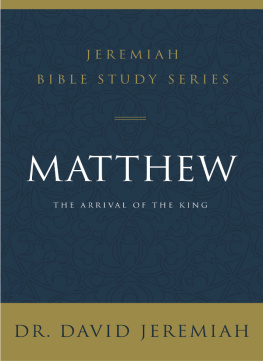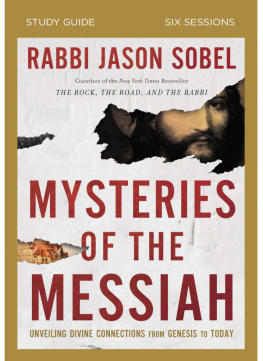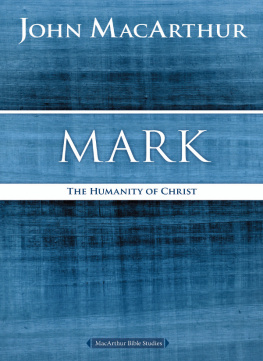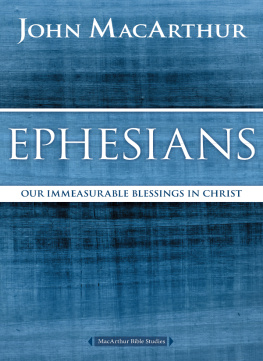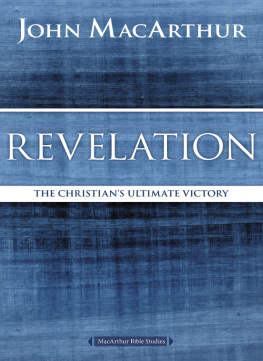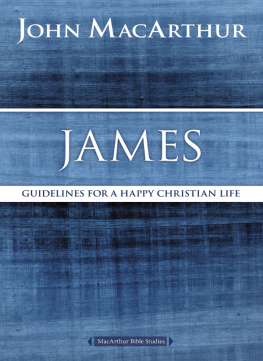MATTHEW
MACARTHUR BIBLE STUDIES
2007, John MacArthur.
All rights reserved. No portion of this book may be reproduced, stored in a retrieval system, or transmitted in any form or by any meanselectronic, mechanical, photocopy, recording, or any otherexcept for brief quotations in printed reviews, without the prior permission of the publisher.
John MacArthur
Unleashing Gods Truth, One Verse at at a Time
Unleashing Gods Truth, One Verse at a Time is a trademark of Grace to You. All rights reserved.
Published in Nashville, Tennessee, by Nelson Books, an imprint of Thomas Nelson. Nelson Books and Thomas Nelson are registered trademarks of HarperCollins Christian Publishing, Inc.
Nelson Books titles may be purchased in bulk for education, business, fundraising, or sales promotional use. For information, please email SpecialMarkets@ThomasNelson.com
Produced with the assistance of the Livingstone Corporation. Project staff include Jake Barton, Mary Horner Collins, and Andy Culbertson.
Project editor: Len Woods
Scripture quotations marked NKJV are taken from The Holy Bible, New King James Version. 1979, 1980, 1982, 1992 Thomas Nelson, Inc. Publishers.
Keys to the Text material taken from the following sources:
The MacArthur Study Bible (electronic ed.), John MacArthur, General Editor. 1997 by Word Publishing. All rights reserved. Used by permission.
Matthew, 17, 815, 1623, 2428 (electronic ed.). MacArthur New Testament Commentary Series. 1989 by John MacArthur. Published by Moody Press, Chicago, Illinois. Used by permission.
Nelsons New Illustrated Bible Dictionary, Rev. ed. R. F. Youngblood, F. F. Bruce, R. K. Harrison, editors. 1995 by Thomas Nelson Publishers.
Cover Art by Holly Sharp Design
Interior Design and Composition by Joel Bartlett, Livingstone Corporation
ISBN 978-0-7180-3501-3
ISBN 978-0-7180-3520-4 (eBook)
15 16 17 18 19 RRD 6 5 4 3 2 1
CONTENTS
Matthew, meaning gift of the Lord, was the other name of Levi (9:9), the tax collector who left everything to follow Christ (Luke 5:27, 28). Matthew was one of the twelve apostles (10:3; Mark 3:18; Luke 6:15; Acts 1:13). In his own list of the twelve disciples, he explicitly calls himself a tax collector (10:3). Nowhere else in Scripture is the name Matthew associated with tax collector; the other evangelists always employ his former name, Levi, when speaking of his sinful past. This is evidence of humility on Matthews part. As with the other three Gospels, this work is known by the name of its author.
AUTHOR AND DATE
The canonicity and Matthean authorship of this gospel were unchallenged in the early church. Eusebius (ca. AD 265339) quotes Origen (ca. AD 185254): Among the four Gospels, which are the only indisputable ones in the church of God under heaven, I have learned by tradition that the first was written by Matthew, who was once a publican, but afterwards an apostle of Jesus Christ, and it was prepared for the converts from Judaism (Ecclesiastical History, 6:25). It is clear that this Gospel was written at a relatively early dateprior to the destruction of the temple in AD 70. Some scholars have proposed a date as early as AD 50.
BACKGROUND AND SETTING
The Jewish flavor of Matthews gospel is remarkable. This is evident even in the opening genealogy, which Matthew traces back only as far as Abraham. In contrast, Luke, aiming to show Christ as the Redeemer of humanity, goes all the way back to Adam. Matthews purpose is somewhat narrower: to demonstrate that Christ is the King and Messiah of Israel. This Gospel quotes more than sixty times from Old Testament prophetic passages, emphasizing how Christ is the fulfillment of all those promises.
The probability that Matthews audience was predominantly Jewish is further evident from several facts. Matthew usually cites Jewish custom without explaining it, in contrast to the other Gospels (see Mark 7:3; John 19:40). He constantly refers to Christ as the Son of David (1:1; 9:27; 12:23; 15:22; 20:30; 21:9, 15; 22:42, 45). Matthew even guards Jewish sensibilities regarding the name of God, referring to the kingdom of heaven where the other evangelists speak of the kingdom of God. All the books major themes are rooted in the Old Testament and set in light of Israels messianic expectations.
Matthews use of Greek may suggest that he was writing as a Palestinian Jew to Hellenistic Jews elsewhere. He wrote as an eyewitness of many of the events he described, giving firsthand testimony about the words and works of Jesus of Nazareth.
His purpose is clear: to demonstrate that Jesus is the Jewish nations long-awaited Messiah. His voluminous quoting of the Old Testament is specifically designed to show the tie between the Messiah of promise and the Christ of history. This purpose is never out of focus for Matthew, and he even adduces many incidental details from the Old Testament prophecies as proof of Jesus messianic claims (e.g., 2:17, 18; 4:1315; 13:35; 21:45; 27:910).
HISTORICAL AND THEOLOGICAL THEMES
Since Matthew is concerned with setting forth Jesus as Messiah, the King of the Jews, a recurring theme throughout this Gospel is an interest in the Old Testament kingdom promises. Matthews signature phrase, the kingdom of heaven, occurs thirty-two times in this book (and nowhere else in all of Scripture).
The opening genealogy is designed to document Christs credentials as Israels king, and the rest of the book completes this theme. Matthew shows that Christ is the heir of the kingly line. He demonstrates that He is the fulfillment of dozens of Old Testament prophecies regarding the king who would come. He offers evidence after evidence to establish Christs kingly prerogative. All other historical and theological themes in the book revolve around this one.
Matthew records five major discourses: the Sermon on the Mount (chs. 57); the commissioning of the apostles (ch. 10); the parables about the kingdom (ch. 13); a discourse about the childlikeness of the believer (ch. 18); and the discourse on His second coming (chs. 24, 25). Each discourse ends with a variation of this phrase: when Jesus had ended these sayings (7:28; 11:1; 13:53; 19:1; 26:1). That becomes a motif signaling a new narrative portion. A long opening section (chs. 14) and a short conclusion (28:1620) bracket the rest of the Gospel, which naturally divides into five sections, each with a discourse and a narrative section. Some have seen a parallel between these five sections and the five books of Moses in the Old Testament.
The conflict between Christ and Pharisaism is another common theme in Matthews Gospel. But Matthew is keen to show the error of the Pharisees for the benefit of his Jewish audiencebut not for personal or self-aggrandizing reasons. Matthew omits, for example, the parable of the Pharisee and the tax collector, even though that parable would have put him in a favorable light.
Matthew also mentions the Sadducees more than any of the other Gospels. Both Pharisees and Sadducees are regularly portrayed negatively, and held up as warning beacons. Their doctrine is a leaven that must be avoided (16:1112). Although these groups were doctrinally at odds with each other, they were united in their hatred of Christ. To Matthew, they epitomized all in Israel who rejected Christ as King.
The rejection of Israels Messiah is another constant theme in this Gospel. In no other Gospel are the attacks against Jesus portrayed as strongly as here. From the flight into Egypt to the scene at the cross, Matthew paints a more vivid portrayal of Christs rejection than any of the other evangelists. In Matthews account of the crucifixion, for example, no thief repents, and no friends or loved ones are seen at the foot of the cross. In His death, He is forsaken even by God (27:46). The shadow of rejection is never lifted from the story.
Next page
